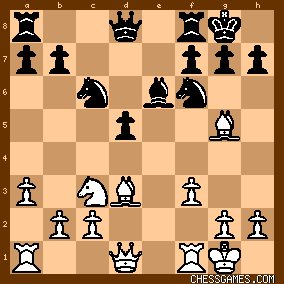| KEG: Going into the 5th round game, Janowski and Blackburne were tied with von Scheve and Alapin for first place (with 3 out of 4) while Tchigorin (with 2.5 with one game to be replayed) was not far behind. With his win in this game, Janowski pulled ahead of the field (Alapin and von Scheve drawing both their replay two days later) and Tchigorin winning his 5th round game but later losing his replay to Schlechter. The game shows a Janowski we rarely get to see, since here it is Blackburne who played for wild complications while Janowski played careful, materialistic chess, picked up every pawn sacrificed by his opponent, and eventually forced resignation with his fine (Xeroxx not inappropriately calls it "sneaky") 29th move. All in all, a fine if uncharacteristic performance by Janowski which found its way into the annotated collection of Janowski's finest games by Cherniaev and Meynell ("C/M"). 1. e4 c5
2. Nc3 Nc6
3. Nf3 e6
4. d4 cxd4
5. Nxd4 Nf6
6. Ndb5

click for larger view6... Bb4
"6...d6 is preferable." (Tournament Book)
6...d6 is most frequently played, but the text has also been played on several occasions and can hardly be called a mistake. 7. a3
"Decidedly better than to check at d6. White [with the text] obtains the advantage of the two Bishops." (Tournament Book). 7... BxN+
8. NxB d5
9. exd5
C/M claims that Fischer got the better endgame against Bolbochan, Mar del Plata, 1959 with 9. Bd3 dxe4 10. Nxe4 NxN 11. BxN QxQ+ 12. KxQ Bd7 13. Be3 f5 14. Bf3 e5 15. b4. But I see no edge for White after 15. b4, and even with the better 15. Kd2 White's edge (with the two Bishops) would be minimal. Strange to say, but Janowski's 9. exd5 appers to be a better positional move than Fischer's 9.Bd3. 9... exd5
9...Nxd5 would also yield White the slightly better game after 10. NxN exN. After 9...exd5, the position was:

click for larger viewJanowski had his beloved two Bishops and Blackburne had an isolated d-pawn. All in all, White's edge here seems greater than in the endgame as occurred in Fischer-Bolbochan. 10. Bd3 0-0
11. 0-0 Bg4
This seems better than the Tournament Book's recommended 11...Be6, and at least as the more frequently played 11...d4. 12. f3 Be6
"The weakness of the isolated pawn begins already to tell." (Tournament Book). The alternative, 12...Qb6+, does not appear to be much of an improvement on Blackburn's move. 13. Bg5

click for larger view"Now White has the advantage because his Bishops (as in the Fischer game) are quite strong." (C/M) Janowski's play to this point (and for most of the rest of the game) could well have been the work of a positional guru such a Karpov. 13... h6
"The advance of the wing pawns is naturally compromising, but the alternative 13...Qb6+ would be a blunder." (Tournament Book). I agree that 13...h6 was probably not best (my vote goes to 13...Re8), but it was not awful, and 13...Qb6+ looks fine to me. The Tournament Book only manages to turn 13...Qb6+ into into a blunder with its poor analysis and bad follow-up for Black. After 13...Qb6+ 14. Kh1, Black would be better off than in the game with 14...Nd7. But the Tournament Book only considered the disastrous 14...Qxb2?, after which Black is indeed lost: 15. Qd2 [White can also win with 15. BxN immediately and then 16. Qd2--KEG] Qb6 [This only makes things worse for Black. 15...Ne5, though not sufficient to save the game, would be less immediately suicidal--KEG] 16. BxN gxB (Black is so bad here that even 16...h6 would be less awful than the natural text move--KEG] 17. Qh6 f5 18. g4 [18. Nxd5 was even better and would leave Black without resource--KEG]. Notably, C/M repeats the mistaken analysis of the Tournament Book. 14. Bh4 | 




